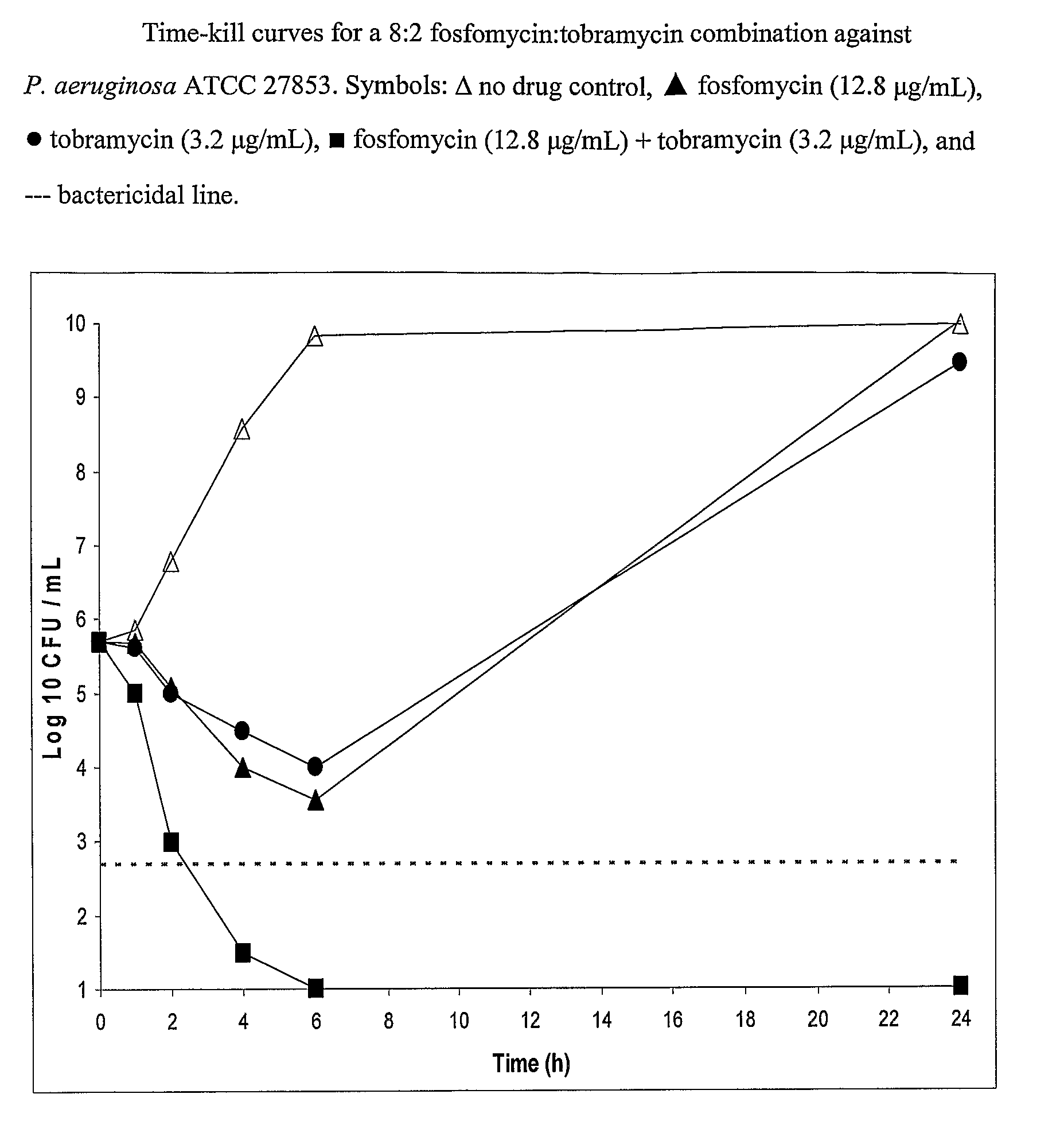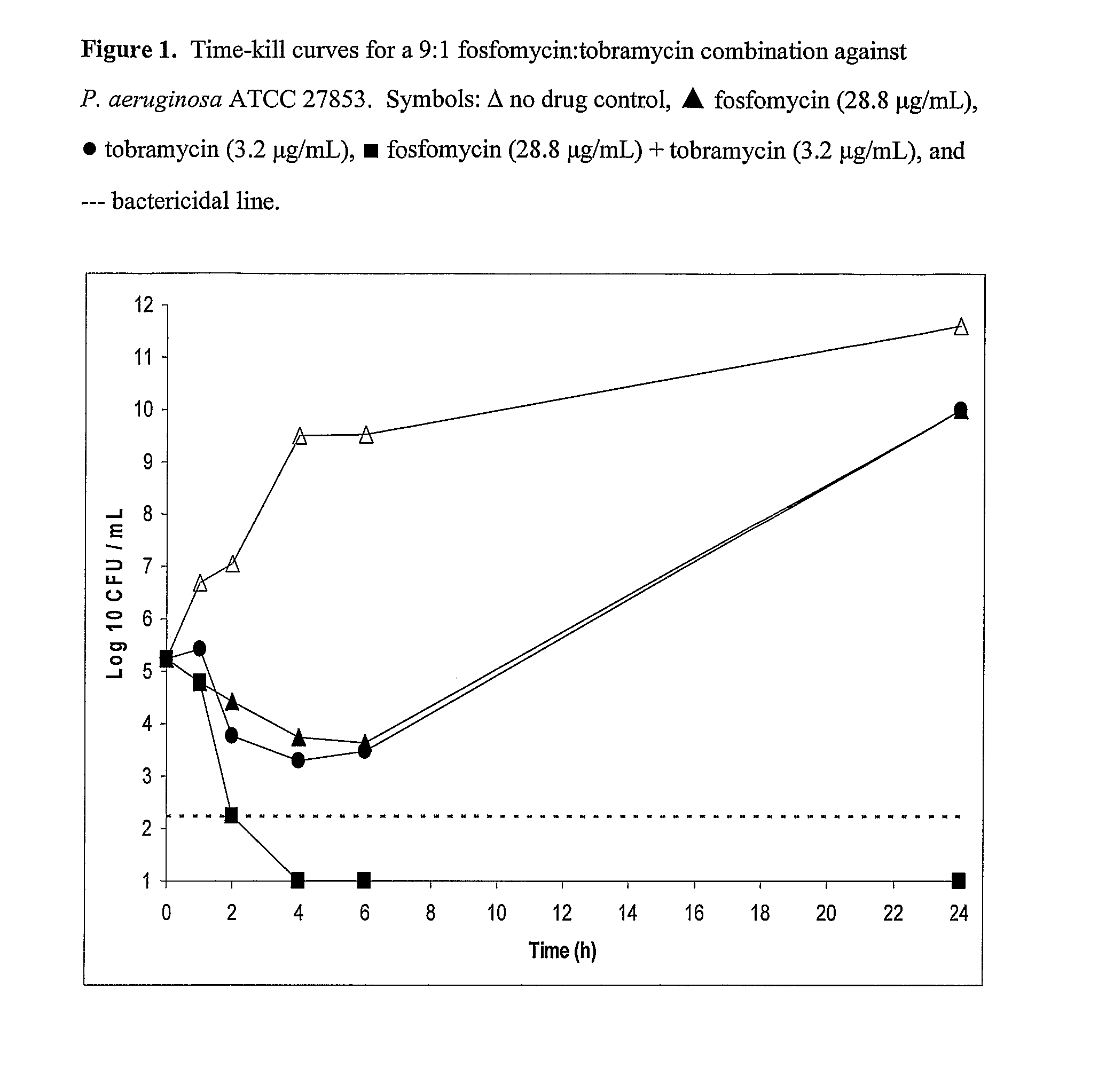Aerosolized fosfomycin/aminoglycoside combination for the treatment of bacterial respiratory infections
a technology of aerosolized fosfomycin and aminoglycoside, which is applied in the direction of aerosol delivery, drug composition, phosphorous compound active ingredients, etc., can solve the problems of insufficient concentration of antibiotics reaching the respiratory tract to ensure rapid onset and high rate of bacterial killing, and the development of adverse side effects, etc., to reduce the development of antibiotic resistance and increase the effect of post-acid a
- Summary
- Abstract
- Description
- Claims
- Application Information
AI Technical Summary
Benefits of technology
Problems solved by technology
Method used
Image
Examples
example 1
Preparation of Fosfomycin / Tobramycin Solutions for Aerosolization
[0097]9:1 Fosfomycin / Tobramycin Solution Fosfomycin disodium (18.057 g, 13.99 g free acid) was dissolved in 250 mL of water and the pH was adjusted to 7.41 by the dropwise addition of 1.53 mL of 4.5 N HCl. To the resulting solution was added 1.56 g of 97.5% tobramycin base. The pH of the solution was adjusted to 7.60 by the addition of 2.45 mL of 4.5 N HCl. The solution was diluted to 500 mL with water and filtered through a 0.2 μm Nalge Nunc 167-0020 membrane filter. The final pH was 7.76, the osmolality was 537 mOsmol / kg, the fosfomycin / tobramycin ratio was calculated to be 9:1, and the chloride concentration was 35.8 mM.
8:2 Fosfomycin / Tobramycin Solution A solution of fosfomycin / tobramycin in a 8:2 ratio was prepared. 3.1680 g of fosfomycin disodium (2.4013 g free acid) was dissolved in 50 ml water. 0.6154 g of 97.5% tobramycin base (0.6000 g of pure tobramycin base) was dissolved in the fosfomycin solution. The pH ...
example 2
Preparation of A 8:2 Hyperosmolar Solution of Fosfomycin and Tobramycin
[0098]7.9165 g of fosfomycin disodium (6.0007 g of fosfomycin free acid) and 1.5382 g of 97.5% tobramycin base (1.4997 g of pure tobramycin base) were dissolved in 50 mL water. The pH was adjusted to 7.62 by the addition of 2.3 mL of 6 M HCl. The combined solution was diluted to 100 mL. The final pH was 7.64, the osmolality was 1215 mOsmol / kg, the final chloride concentration was 138 mM, and the fosfomycin / tobramycin ratio was 8:2.
example 3
Preparation of Individual Solutions of High pH Fosfomycin and Low pH Tobramycin for Reconstitution
[0099]A fosfomycin solution was prepared by dissolving 5.891 g of fosfomycin disodium (4.465 g of fosfomycin free acid) in water and diluting to 100 mL. The pH was 9.42, and the osmolality was 795 mOsmol / kg.
[0100]A tobramycin solution was prepared by dissolving 1.869 g of 97.5% tobramycin base (1.822 g of pure tobramycin base) in 60 mL water, adjusting the pH to 4.90 by adding 18.8 mL of 1 M HCl, and diluting to 100 ml with water. The pH was 4.89, and the osmolality was 148 mOsmol / kg.
[0101]1 mL of the fosfomycin solution and 1 mL of the tobramycin solution were combined. For the combined drug product solution, the pH was 7.30, the osmolality was 477 mOsmol / kg, the chloride concentration was 94.0 mM, and the fosfomycin / tobramycin ratio was 7:3.
PUM
| Property | Measurement | Unit |
|---|---|---|
| concentrations | aaaaa | aaaaa |
| concentrations | aaaaa | aaaaa |
| sizes | aaaaa | aaaaa |
Abstract
Description
Claims
Application Information
 Login to View More
Login to View More - R&D
- Intellectual Property
- Life Sciences
- Materials
- Tech Scout
- Unparalleled Data Quality
- Higher Quality Content
- 60% Fewer Hallucinations
Browse by: Latest US Patents, China's latest patents, Technical Efficacy Thesaurus, Application Domain, Technology Topic, Popular Technical Reports.
© 2025 PatSnap. All rights reserved.Legal|Privacy policy|Modern Slavery Act Transparency Statement|Sitemap|About US| Contact US: help@patsnap.com



